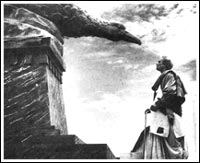
MOVIES | FEEDBACK |

Dinesh Raheja
Kagaz Ke Phool is that rare film whose commercial failure is famous. Its disappointment is known to have dispirited a genius like Guru Dutt.
Ironically, it is somehow in conjunction with Guru Dutt's oft-expressed cynical view of worldly fame (Yeh duniya agar mil bhi jaaye toh kya hai?) that today the film is considered no less than a cult classic.
The bare bones of Kagaz Ke Phool's story are reminiscent of the Hollywood classic A Star Is Born, but the extraordinarily sensitive Guru Dutt makes it his own vision with photographic stylisations, his understanding of irony and his profound sympathy for the human condition.
Of course watching this thickly atmospheric movie does become a rather morose experience. But go beyond the pall of gloom and the unevenly developed screenplay (parts are plain pallid and some sequences exasperatingly self-indulgent) and you find moments of piercing brilliance that give you a glimpse into the heart of the artiste.
Kagaz Ke Phool's protagonist Suresh's (Guru Dutt) first loss is that of his wife. The film is largely narrated in a flashback a la Sahib Biwi Aur Ghulam. We are shown that film director Suresh's wife (Veena) is estranged, and has taken his beloved daughter (Baby Naaz) with her. Dutt rather unconvincingly spoofs the brown sahibs with his 'Dear me' mother-in-law and 'My boy' father-in-law.
Suresh's brother-in-law Jimmy (Johnny Walker) is sympathetic towards him. Unfortunately, unlike Johnny's delightful turns in
Dutt's earlier films like Pyaasa (Sar jo tera chakraye) and Mr And Mrs 55 (Jaane kahan mera jigar), this time around he is a glaring plot contrivance to relieve the rather unrelenting tension. Though he keeps making his appearance intermittently, his character just does not pan out interestingly.
Expectedly, the film is at its best when dealing with Dutt's relationship with Waheeda. Suresh who is a stiff-backed principled
film director (uncompromising like in Pyaasa) meets Shanti (Waheeda), while both are taking cover from the rain. Poor Shanti doesn't have a coat (Sardi zukaam muft mein milte hai; garm coat ke liye paise lagte hai) and Suresh gives her his coat -- no strings attached.
This humanitarian tendency in Dutt's films --- even in Pyaasa he gives away his coat --- is for me one of the most endearing aspects of Dutt's films. His sympathy for the underprivileged (whether it is the extra in Kagaz Ke Phool, the chhoti bahu in Sahib Biwi Aur Ghulam or the prostitute in Pyaasa) is at least as palpable as his acute empathy for himself.
Suresh forgets having donated the coat; but Shanti comes to the studio to return it and blunders into the camera's vision. Suresh is captivated by the expressive face he sees from behind the camera and decides to cast her as the heroine of his film,
pointedly titled Devdas.
The gradual falling in love between the debutante and the older married director is softly muted. She hero-worships him and nurses him when he falls ill, while he initially tries to fight the strong undertow of attraction. The line from Waqt ne kiya (shot in a fascinating interplay of light and shade and subconscious) says it all:
Jayenge kahan sujhta nahin
But when Suresh's daughter pleads with Shanti to give up her father so that she can reunite her parents, Shanti quietly accedes to her wishes and even retires from acting. Suresh understands Shanti's sacrifice, but finds it difficult to withstand the pain of one more separation.
When he loses his daughter too in a custody case, his life goes into a tailspin. He loses interest in his work, his film flops, his finances dwindle and he drowns all his sorrows in drink.
He is fated to meet Shanti once again when the still-in-love-with-him actress pleads with him to direct her comeback film. But Suresh stubbornly refuses to accept what he sees as a favour. The once-felicitated director works instead in a bit role for a pittance and faces insults in the studio. Finally, he creeps back to an empty set, sits on the director's chair, and quietly passes away.
Barely registering his death, the filmmakers clear the set in an ironic assertion of the glamour world --- the show must go on.
Kagaz Ke Phool does seem unrelenting in its narration of its protagonist's tragedies and later, in his surly acceptance of the same. One wishes he would take help to get his life back on the tracks.
Guru Dutt maintains a heightened emotional fervour and tinges his central love story with a heart-breaking air of what-could-have-been. What is also refreshing is the quiet nature of their love story. Their line, Hamne hamesha ek doosre ko samjha hai conveys the depth of their emotion more than reams of dialogue.
Guru Dutt and Waheeda act beautifully, deepening our understanding of their characters. With the aid of cameraman V K Murthy, Dutt creates some unforgettable images. The two premieres (one of a successful film, one of a flop) are strikingly contrasted and the huge empty sets are evocatively lit.
And of course, there is the climactic scene where Guru Dutt is dressed as an extra but runs away when Waheeda spots him. With Ud ja ud ja panchi playing plaintively in the background, Waheeda flees after him but once outside the studio gates, is besieged by autograph-hungry fans.
The scene was wishy washily recreated in Amitabh Bachchan's Hum, but it is Kagaz Ke Phool's soul. Even if it had just this one moment, Kagaz Ke Phool would have deservedly joined the ranks of classics.
Sidelights:
* Disturbed by the film's commercial failure Guru Dutt didn't take his name as a director for any of his subsequent films.
The Music:
You might also want to read:
|
||||||
© 1996 - 2002 rediff.com India Limited. All Rights Reserved. |
|||||||